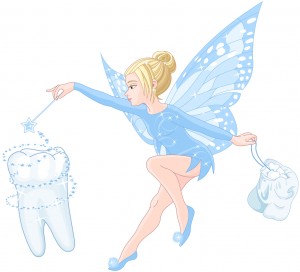Losing baby teeth to make way for permanent adult teeth is an important rite of childhood. Along with the loss of those precious little teeth is the mythological tooth fairy, who comes in the middle of the night to replace a lost tooth placed underneath the child’s pillow with a small payment. It’s a fun, enjoyable custom for young children who might otherwise be upset and uncomfortable with the loss of a tooth. But when and where did the tooth fairy first originate, and how did it come to be such a popular character of early childhood?
Tooth Fairy Origins
The tooth fairy mythology may have started in early Europe. In Northern Europe, the custom was spoken of in early writings such as the Norse Eddas, where the payment was referred to as the tand-fé (tooth fee). Various superstitions about children’s teeth arose in the Middle Ages. Children in England were told to burn their baby teeth so that they would not have to search for them in their afterlife. As part of Norse culture, Vikings would also pay children for their teeth. Children’s belongings, including their teeth, were believed to give them good fortune in battle. Viking warriors would often wear children’s teeth as necklaces. In olden days, a fear of witches was another reason that people would burn or bury their teeth. A medieval European belief was that if a witch got hold of your teeth, they would have power over you.
The earliest mention of a more modern tooth fairy dates to 1908, with a reference in the Chicago Daily Tribune. In an article titled “Household Hints,” it is recommended that mothers make purchases at the 5-cent counter to replace a tooth from under a pillow with a small gift. The reward value varied by country, the family’s financial status and tooth fees paid to the child’s peers. American children in 2013 would receive, on average, $3.70 per tooth.
What Does the Tooth Fairy Look Like?
Unlike the fairly consistent appearance of other mythological figures like the Easter Bunny and Santa Claus, what the tooth fairy looks like seems to be a matter of opinion. Studies have shown that most believe the tooth fairy is female, and the usual depiction is of a delicate, fairy-like creature with wings and a wand. Artwork in children’s books often show the tooth fairy as a pixie, a child or a ballerina. They might also be depicted as a mother-figure or even a dragon.
Do You Believe in the Tooth Fairy?
While parents might wonder if it’s a good thing to perpetuate the myth of the tooth fairy, it has been found that young children, once they learn that the tooth fairy doesn’t really exist, still enjoy the custom. Research has shown that belief in a tooth fairy can provide some comfort to a frightened child, while parents may value this tradition and the tooth fairy fictional character as a precious part of their baby’s early life, before they grow up and reality infringes on their fantasy life.
Tooth Fairies Around the World
While the tooth fairy is typically a custom in English-speaking countries, many regions from around the world have similar traditions. In Hispanic American and Spanish cultures, the Ratoncito Pérez (“Pérez Mouse” in English), which originated in Madrid in 1894, exchanges the tooth under the child’s pillow with a gift. It is the same in other Spanish speaking areas, though in Peru, Chile and Mexico he’s known as “el Ratón de los Dientes” (The Tooth Mouse). In Italy, France and Belgium, the tooth fairy is also a small mouse. In Scotland, it is a white fairy rat that buys children’s teeth with coins.








Leave a Reply